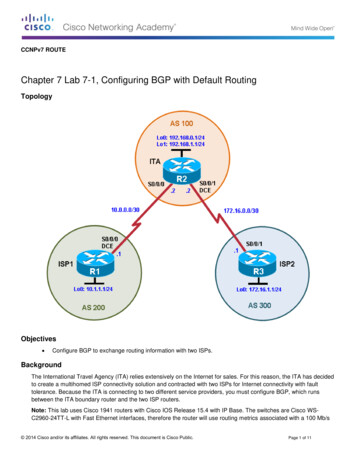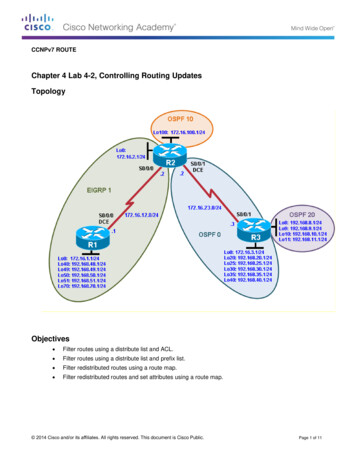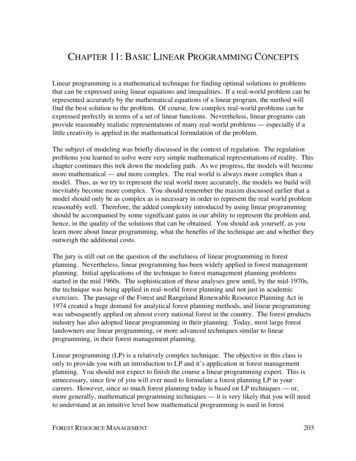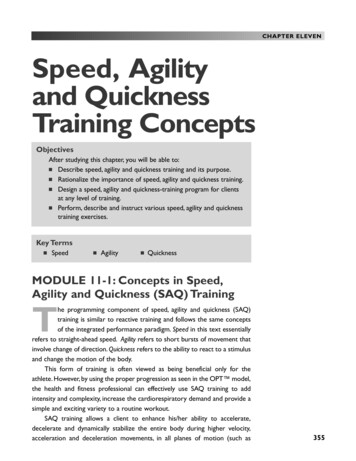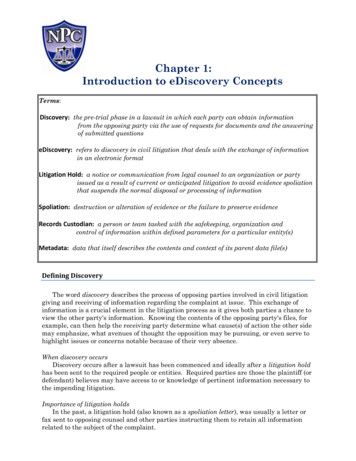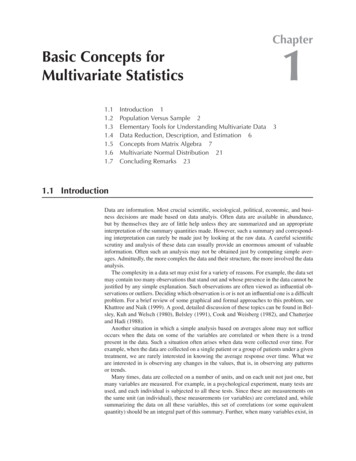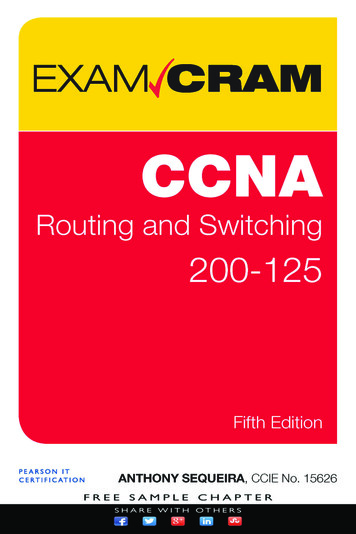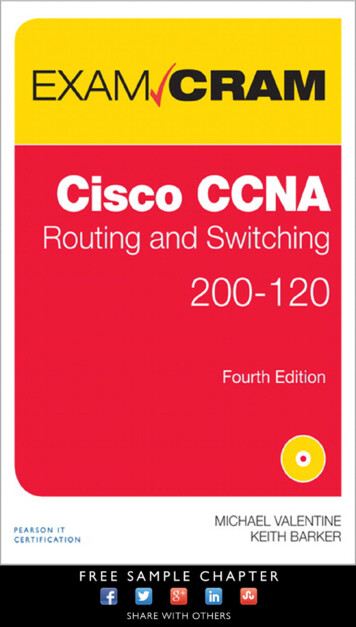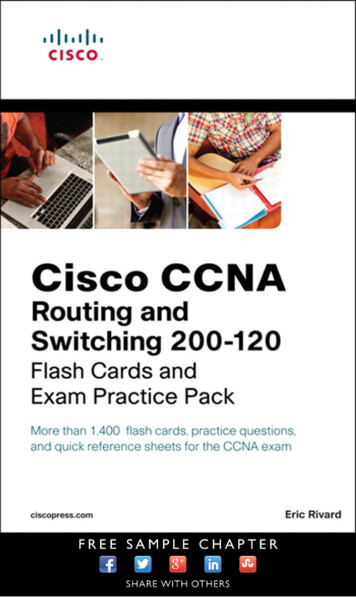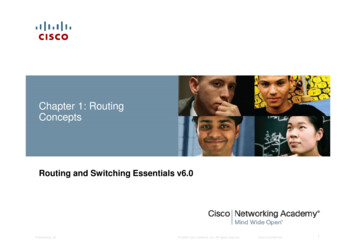
Transcription
Chapter 1: RoutingConceptsRouting and Switching Essentials v6.0Presentation ID 2008 Cisco Systems, Inc. All rights reserved.Cisco Confidential1
Chapter 1 - Sections & Objectives1.1 Router Initial Configuration Describe the primary functions and features of a router. Configure basic settings on a router to route between two directly-connectednetworks, using CLI. Verify connectivity between two networks that are directly connected to arouter.1.2 Routing Decisions Explain the encapsulation and de-encapsulation process used by routers whenswitching packets between interfaces. Explain the path determination function of a router.1.3 Router OperationPresentation ID Explain routing table entries for directly connected networks. Explain how a router builds a routing table of directly connected networks. Explain how a router builds a routing table using static routes. Explain how a router builds a routing table using a dynamic routing protocol. 2008 Cisco Systems, Inc. All rights reserved.Cisco Confidential2
1.1 Router InitialConfigurationPresentation ID 2008 Cisco Systems, Inc. All rights reserved.Cisco Confidential3
Router FunctionsCharacteristics of a NetworkPresentation ID 2008 Cisco Systems, Inc. All rights reserved.Cisco Confidential4
Router FunctionsWhy Routing?The router is responsible for the routing of trafficbetween networks.Presentation ID 2008 Cisco Systems, Inc. All rights reserved.Cisco Confidential5
Router FunctionsRouters are ComputersRouters are specialized computers containing the followingrequired components to operate:Presentation ID Central processing unit (CPU) Operating system (OS) - Routers use Cisco IOS Memory and storage (RAM, ROM, NVRAM, Flash, hard drive) 2008 Cisco Systems, Inc. All rights reserved.Cisco Confidential6
Router FunctionsRouters are Computers (cont.)Routers use specialized ports and network interface cards tointerconnect to other networks.Presentation ID 2008 Cisco Systems, Inc. All rights reserved.Cisco Confidential7
Router FunctionsRouters are ComputersRouter MemoryPresentation ID 2008 Cisco Systems, Inc. All rights reserved.Cisco Confidential8
Router FunctionsRouters Interconnect NetworksPresentation ID 2008 Cisco Systems, Inc. All rights reserved.Cisco Confidential9
Router FunctionsRouters Choose Best Paths Routers use static routes and dynamic routing protocols to learnabout remote networks and build their routing tables. Routers use routing tables to determine the best path to sendpackets. Routers encapsulate the packet and forward it to the interfaceindicated in routing table.Presentation ID 2008 Cisco Systems, Inc. All rights reserved.Cisco Confidential10
Router FunctionsPacket Forwarding Methods Process switching – Anolder packet forwardingmechanism still available forCisco routers. Fast switching – A commonpacket forwardingmechanism which uses afast-switching cache to storenext hop information. Cisco Express Forwarding(CEF) – The most recent,fastest, and preferred CiscoIOS packet-forwardingmechanism.Presentation ID 2008 Cisco Systems, Inc. All rights reserved.Cisco Confidential11
Connect DevicesConnect to a NetworkPresentation ID 2008 Cisco Systems, Inc. All rights reserved.Cisco Confidential12
Connect DevicesDefault GatewaysTo enable networkaccess devices, must beconfigured with thefollowing IP addressinformation: IP address - Identifies aunique host on a localnetwork. Subnet mask - Identifiesthe host’s network subnet. Default gateway Identifies the router apacket is sent to when thedestination is not on thesame local networksubnet.Presentation ID 2008 Cisco Systems, Inc. All rights reserved.Cisco Confidential13
Connect DevicesDocument Network AddressingNetwork documentation should include at least the following in a topology diagramand addressing table: Device names Interfaces IP addresses andsubnet masks Default gatewaysPresentation ID 2008 Cisco Systems, Inc. All rights reserved.Cisco Confidential14
Connect DevicesEnable IP on a HostStatically Assigned IP address – The host is manually assigned an IPaddress, subnet mask and default gateway. A DNS server IP address canalso be assigned. Used to identify specific network resources such as network serversand printers. Can be used in very small networks with few hosts.Dynamically Assigned IP Address – IP Address information isdynamically assigned by a server using Dynamic Host ConfigurationProtocol (DHCP). Most hosts acquire their IP address information through DHCP. DHCP services can be provided by Cisco routers.Presentation ID 2008 Cisco Systems, Inc. All rights reserved.Cisco Confidential15
Connect DevicesEnable IP on a HostPresentation ID 2008 Cisco Systems, Inc. All rights reserved.Cisco Confidential16
Connect DevicesEnable IP on a HostPresentation ID 2008 Cisco Systems, Inc. All rights reserved.Cisco Confidential17
Connect devicesDevice LEDsPresentation ID 2008 Cisco Systems, Inc. All rights reserved.Cisco Confidential18
Console AccessConnect DevicesConsole AccessPresentation ID 2008 Cisco Systems, Inc. All rights reserved.Cisco Confidential19
Connect DevicesEnable IP on a Switch Network infrastructure devices require IP addresses to enable remotemanagement. On a switch, the management IP address is assigned on a virtual interfacecalled a switched virtual interface (SVI)Presentation ID 2008 Cisco Systems, Inc. All rights reserved.Cisco Confidential20
Router Basic SettingsConfigure Router Basic Settings Name the device – Distinguishesit from other routers Secure management access –Secures privileged EXEC, userEXEC, and Telnet access, andencrypts passwords . Configure a banner – Provideslegal notification of unauthorizedaccess. Save the ConfigurationPresentation ID 2008 Cisco Systems, Inc. All rights reserved.Cisco Confidential21
Router Basic SettingsConfigure an IPv4 Router InterfaceTo be available, a router interfacemust be: Configured with an address and subnetmask. Activated using no shutdowncommand. By default LAN and WANinterfaces are not activated. Configured with the clockrate command on the Serial cable endlabeled DCE.Optional description can be included.Presentation ID 2008 Cisco Systems, Inc. All rights reserved.Cisco Confidential22
Router Basic SettingsConfigure an IPv6 Router InterfaceConfigure interface with IPv6 address and subnet mask: Use the ipv6 address ipv6-address/ipv6-length [link-local eui-64]interface configurationcommand. Activate using the no shutdown command.Presentation ID 2008 Cisco Systems, Inc. All rights reserved.Cisco Confidential23
Router Basic SettingsConfigure an IPv6 Router Interface (cont.)IPv6 interfaces can support more than one address: Configure a specified global unicast – ipv6address ipv6address /ipv6-length Configure a global IPv6 address with an interface identifier (ID) in thelow-order 64 bits - ipv6address ipv6-address /ipv6-length eui-64 Configure a link-local address - ipv6address ipv6-address /ipv6length link-localPresentation ID 2008 Cisco Systems, Inc. All rights reserved.Cisco Confidential24
Router Basic SettingsConfigure an IPv4 Loopback InterfaceA loopback interface is a logical interface that is internal to therouter: It is not assigned to a physical port, it is considered a software interface that isautomatically in an UP state. A loopback interface is useful for testing. It is important in the OSPF routing process.Presentation ID 2008 Cisco Systems, Inc. All rights reserved.Cisco Confidential25
Verify Connectivity of Directly Connected NetworksVerify Interface SettingsShow commands are used toverify operation and configurationof interface: show ip interfaces brief show ip route show running-configShow commands that are used togather more detailed interfaceinformation: show interfaces show ip interfacesPresentation ID 2008 Cisco Systems, Inc. All rights reserved.Cisco Confidential26
Verify Connectivity of Directly Connected NetworksVerify Interface Settings (cont.)Presentation ID 2008 Cisco Systems, Inc. All rights reserved.Cisco Confidential27
Verify Connectivity of Directly Connected NetworksVerify IPv6 Interface SettingsCommon commands to verify the IPv6 interface configuration: show ipv6 interface brief - displays a summary for each of the interfaces. show ipv6 interface gigabitethernet 0/0 - displays the interface status and all the IPv6addresses for this interface. show ipv6 route - verifies that IPv6 networks and specific IPv6 interface addresses havebeen installed in the IPv6 routing table.Presentation ID 2008 Cisco Systems, Inc. All rights reserved.Cisco Confidential28
Verify Connectivity of Directly Connected NetworksFilter Show Command OutputShow command output can be managed using the followingcommand and filters: Use the terminal length number command to specify the number of lines to bedisplayed. To filter specific output of commands use the ( )pipe character after showcommand. Parameters that can be used after pipe include: section, include, exclude, beginPresentation ID 2008 Cisco Systems, Inc. All rights reserved.Cisco Confidential29
Verify Connectivity of Directly Connected NetworksCommand History FeatureThe command history feature temporarily stores a list of executedcommands for access: To recall commands press Ctrl P or the UP Arrow. To return to more recent commands press Ctrl N or the Down Arrow. By default, command history is enabled and the system captures the last 10 commandsin the buffer. Use the show history privileged EXEC command to display the buffercontents. Use the terminal history size user EXEC command to increase or decrease size ofthe buffer.Presentation ID 2008 Cisco Systems, Inc. All rights reserved.Cisco Confidential30
1.2 Routing DecisionsPresentation ID 2008 Cisco Systems, Inc. All rights reserved.Cisco Confidential31
Switching Packets Between NetworksRouter Switching FunctionPresentation ID 2008 Cisco Systems, Inc. All rights reserved.Cisco Confidential32
Switching Packets Between NetworksSend a PacketPresentation ID 2008 Cisco Systems, Inc. All rights reserved.Cisco Confidential33
Switching Packets Between NetworksForward to Next HopPresentation ID 2008 Cisco Systems, Inc. All rights reserved.Cisco Confidential34
Switching Packets Between NetworksPacket RoutingPresentation ID 2008 Cisco Systems, Inc. All rights reserved.Cisco Confidential35
Switching Packets Between NetworksReach the DestinationPresentation ID 2008 Cisco Systems, Inc. All rights reserved.Cisco Confidential36
Path DeterminationRouting DecisionsPresentation ID 2008 Cisco Systems, Inc. All rights reserved.Cisco Confidential37
Path DeterminationBest Path Best path is selected by a routing protocol based on the value ormetric it uses to determine the distance to reach a network:o A metric is the value used to measure the distance to a given network.o Best path to a network is the path with the lowest metric. Dynamic routing protocols use their own rules and metrics to buildand update routing tables:o Routing Information Protocol (RIP) - Hop counto Open Shortest Path First (OSPF) - Cost based on cumulative bandwidth from source todestinationo Enhanced Interior Gateway Routing Protocol (EIGRP) - Bandwidth, delay, load, reliabilityPresentation ID 2008 Cisco Systems, Inc. All rights reserved.Cisco Confidential38
Path DeterminationLoad Balancing When a router has two or more paths to a destination with equal costmetrics, then the router forwards the packets using both paths equally:oEqual cost load balancing can improve network performance.oEqual cost load balancing can be configured to use both dynamic routing protocols andstatic routes.Presentation ID 2008 Cisco Systems, Inc. All rights reserved.Cisco Confidential39
Path DeterminationAdministrative Distance If multiple paths to a destination are configured on a router, the pathinstalled in the routing table is the one with the lowest AdministrativeDistance (AD):oA static route with an AD of 1 is more reliable than an EIGRP-discovered route with anAD of 90.oA directly connected route with an AD of 0 is more reliable than a static route with an ADof 1.Presentation ID 2008 Cisco Systems, Inc. All rights reserved.Cisco Confidential40
1.3 Router OperationPresentation ID 2008 Cisco Systems, Inc. All rights reserved.Cisco Confidential41
Analyze the Routing TableThe Routing Table A routing table is a file stored in RAM that contains information about:o Directly connected routeso Remote routesPresentation ID 2008 Cisco Systems, Inc. All rights reserved.Cisco Confidential42
Analyze the Routing TableRouting Table SourcesThe show ip route command is used to display the contents of the routingtable:o Local route interfaces - Added to the routing table when an interface is configured.(displayed in IOS 15 or newer for IPv4 routes and all IOS releases for IPv6 routes.)o Directly connected interfaces - Added to the routing table when an interface isconfigured and active.o Static routes - Added when a route is manually configured and the exit interface is active.o Dynamic routing protocol - Added when EIGRP or OSPF are implemented andnetworks are identified.Presentation ID 2008 Cisco Systems, Inc. All rights reserved.Cisco Confidential43
Analyze the Routing TableRouting Table Sources (cont.)Presentation ID 2008 Cisco Systems, Inc. All rights reserved.Cisco Confidential44
Analyze the Routing TableRemote Network Routing EntriesInterpreting the entries in the routing tablePresentation ID 2008 Cisco Systems, Inc. All rights reserved.Cisco Confidential45
Directly Connected RoutesDirectly Connected InterfacesA newly deployed router, without any configured interfaces, has an emptyrouting table.Presentation ID 2008 Cisco Systems, Inc. All rights reserved.Cisco Confidential46
Directly Connected RoutesDirectly Connected Routing Table EntriesPresentation ID 2008 Cisco Systems, Inc. All rights reserved.Cisco Confidential47
Directly Connected RoutesDirectly Connected ExamplePresentation ID 2008 Cisco Systems, Inc. All rights reserved.Cisco Confidential48
Directly Connected RoutesDirectly Connected IPv6 ExamplePresentation ID 2008 Cisco Systems, Inc. All rights reserved.Cisco Confidential49
Statically Learned RoutesStatic RoutesStatic routes and default static routes can be implemented afterdirectly connected interfaces are added to the routing table:o Static routes are manually configured.o They define an explicit path between two networking devices.o Static routes must be manually updated if the topology changes.o Their benefits include improved security and control of resources.o Configure a static route to a specific network using the ip route networkmask {next-hop-ip exit-intf} command.o A default static route is used when the routing table does not contain apath for a destination network.o Configure a default static route using the ip route 0.0.0.0 0.0.0.0 {exitintf next-hop-ip} command.Presentation ID 2008 Cisco Systems, Inc. All rights reserved.Cisco Confidential50
Statically Learned RoutesStatic Route ExamplePresentation ID 2008 Cisco Systems, Inc. All rights reserved.Cisco Confidential51
Statically Learned RoutesStatic Route Example (cont.)Entering and Verifying a Static RoutePresentation ID 2008 Cisco Systems, Inc. All rights reserved.Cisco Confidential52
Statically Learned RoutesStatic IPv6 Route ExamplesPresentation ID 2008 Cisco Systems, Inc. All rights reserved.Cisco Confidential53
Statically Learned RoutesStatic IPv6 Route ExamplesPresentation ID 2008 Cisco Systems, Inc. All rights reserved.Cisco Confidential54
Dynamic Routing ProtocolsDynamic Routing Dynamic routing is used byrouters to share informationabout the reachability andstatus of remote networks. It performs networkdiscovery and maintainsrouting tables. Routers have convergedafter they have finishedexchanging and updatingtheir routing tables.Presentation ID 2008 Cisco Systems, Inc. All rights reserved.Cisco Confidential55
Dynamic Routing ProtocolsIPv4 Routing ProtocolsCisco routers can support a variety of dynamic IPv4 routing protocolsincluding: EIGRP – Enhanced Interior Gateway Routing Protocol OSPF – Open Shortest Path First IS-IS – Intermediate System-to-Intermediate System RIP – Routing Information ProtocolUse the router ? Command in global configuration mode to determinewhich routing protocols are supported by the IOS.Presentation ID 2008 Cisco Systems, Inc. All rights reserved.Cisco Confidential56
Dynamic Routing ProtocolsIPv4 Dynamic Routing ExamplesPresentation ID 2008 Cisco Systems, Inc. All rights reserved.Cisco Confidential57
IPv6 Routing ProtocolsDynamic Routing ProtocolsIPv6 Routing ProtocolsCisco routers can support a variety of dynamic IPv6 routing protocolsincluding:o RIPng (RIP next generation)o OSPFv3o EIGRP for IPv6Use the ipv6 router ? command to determine which routingprotocols are supported by the IOSPresentation ID 2008 Cisco Systems, Inc. All rights reserved.Cisco Confidential58
Dynamic Routing ProtocolsIPv6 Dynamic Routing ExamplesPresentation ID 2008 Cisco Systems, Inc. All rights reserved.Cisco Confidential59
1.4 Chapter SummaryPresentation ID 2008 Cisco Systems, Inc. All rights reserved.Cisco Confidential60
Chapter SummarySummary Describe the primary functions and features of a router. Configure basic settings on a router to route between two directly-connected networks,using CLI. Verify connectivity between two networks that are directly connected to a router. Explain how routers use information in data packets to make forwarding decisions in asmall to medium-sized business network. Explain the encapsulation and de-encapsulation process used by routers when switchingpackets between interfaces. Explain the path determination function of a router. Explain how a router learns about remote networks when operating in a small to mediumsized business network. Explain how a router builds a routing table of directly connected networks. Explain how a router builds a routing table using static routes. Explain how a router builds a routing table using a dynamic routing protocol.Presentation ID 2008 Cisco Systems, Inc. All rights reserved.Cisco Confidential61
Presentation ID 2008 Cisco Systems, Inc. All rights reserved.Cisco Confidential62
Dynamic routing protocols use their own rules and metrics to build and update routing tables: o Routing Information Protocol (RIP) - Hop count o Open Shortest Path First (OSPF) - Cost based on cumulative bandwidth from source to destination o Enhanced Interior Gateway Routi

